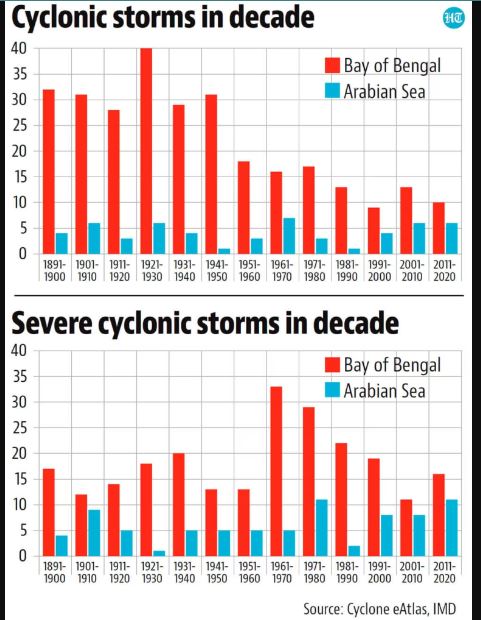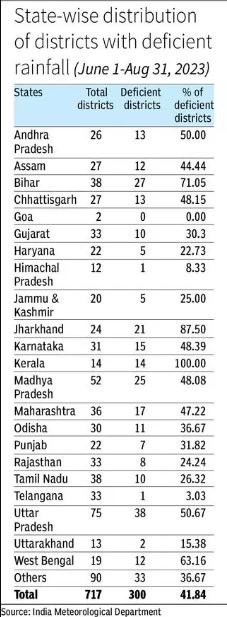CONTENT
- Before the Waters Rise
- India is Staring at Water Poverty
Before The Waters Rise
Context:
Intense rainfall and flooding have been documented across various north Indian states in recent months, shedding light on a concerning situation. Although India has established a robust early warning system (EWS) for cyclones, there are significant deficiencies in our capacity to issue flood alerts. As we confront the rising challenges of climate extremes, EWS are becoming an indispensable instrument for mitigating disaster risks.
Relevance:
GS3- Disaster Management
Mains Question:
Early Warning Systems are becoming an indispensable instrument for mitigating disaster risks. Analysing the current performance of EWS in cyclone management in India, highlight what more can be done in this regard? (15 marks, 250 words).
Status of population affected by extreme disasters:
- A recent study conducted by the Council on Energy, Environment, and Water has observed that although the entire population residing in cyclone-prone regions of India is covered by EWS, only 33% of those living in flood-prone areas have access to such systems.
- India has faced more than 300 extreme climate events in the past two decades, and this means that 66% of the Indian population is vulnerable to severe floods, which equates to two out of every three Indians.

Significance of Early Warning Systems (EWS):
- Recent years have seen EWS prove highly effective, leading to successful evacuations and a decrease in the loss of life during events such as Cyclone Phailin, Cyclone Fani, and the most recent one, Cyclone Biparjoy.
- The success of these cyclone EWS can be attributed to three key factors:
- extensive coverage of cyclone-prone regions,
- investments in advanced technology for accurate storm predictions,
- and widespread dissemination of warnings to enable early actions.
- EWS plays a crucial role in reducing both human casualties and economic losses resulting from extreme weather events by alerting communities at risk in a timely manner. The Central Water Commission has established 331 flood monitoring stations and issues around 10,000 flood forecasts annually.
To enhance the effectiveness of cyclone EWS, the following measures should be implemented:
| Initiative | Example |
| State governments must prioritize investments in regional, real-time flood monitoring microsensors. These sensors enable accurate and real-time data collection, which can assist the Central Water Commission (CWC) in enhancing the precision and specificity of flood forecasts. | Karnataka State Natural Disaster Management Centre has already installed 132 water-level sensors in flood-prone areas to implement technology-driven solutions for urban flooding. |
| Indian government should ensure active community involvement as it scales up multi-hazard early warning systems for floods. Multi-hazard early warning systems have the capability to alert about multiple hazards, increasing the efficiency and consistency of warnings. By engaging communities in these systems, last-mile connectivity and efficient information dissemination can be achieved. | A study conducted in Nepal indicates that the benefit-cost ratio for investing in community-based flood EWS ranges from 24 to 73 for every Nepalese rupee spent, making it a worthwhile endeavor. |
| The government should actively promote collaborations with the private sector to leverage state-of-the-art technology. | States like Assam, Bihar, Maharashtra, and Tamil Nadu have set commendable examples in this regard. Public-private partnerships can stimulate innovation and the scaling of technological solutions for disaster risk reduction. |
| Funds should be directed towards making flood early warnings more impact-based. A more integrated effort to channel funds into building robust systems that can accurately forecast floods at least 48-72 hours before the event occurs will provide sufficient time to evacuate people to safety. | To bolster flood preparedness and mitigate its impacts, a significant portion of the proposed Rs 15,000 crore fund for the Flood Management and Border Area Programme in India should be allocated to the development of impact-based flood early warning systems. |
Conclusion:
India has been a leader in advocating early warnings for cyclones. Now, it must take the lead in championing impact-based, people-centric, multi-hazard early warning systems for floods.
India is staring at Water Poverty
Context:
Based on recently released data from the India Meteorological Department, the South-West monsoon for the June to August 2023 period has been inadequate in 42 percent of the districts (see the table for reference). Specifically, in August, the country witnessed a rainfall deficit of 32 percent compared to the normal average, with the southern states experiencing a particularly severe shortfall of 62 percent. This year has marked the lowest August rainfall in India in the past 122 years, tracing back to 1901. With only around one month remaining before the conclusion of the South-West monsoon season, the reduced precipitation not only poses a significant threat to agriculture but also raises concerns about potential widespread water shortages in various regions of the country.

Relevance:
GS3-Mobilization of Resources, Conservation, Environmental Pollution and Degradation
Mains Question:
The decline in South-west monsoons rains poses a significant threat to agriculture while raising questions about potential widespread water shortages. Examine. (10 marks, 150 words).
Water Scarcity in India:
- The total annual usable water supply in our country is estimated at 1,121 billion cubic meters (bcm). However, data published by the Ministry of Water Resources indicates that the overall water demand will reach 1,093 bcm by 2025 and 1,447 bcm by 2050. This projection implies a significant water shortage in India within the next decade.
- According to the Falkenmark Water Index, widely used to measure water scarcity worldwide, any region with less than 1,700 cubic meters of available water per capita annually is considered to be experiencing water scarcity. According to this index, almost 76 percent of India’s population is already living with water scarcity.
- In the case of Tamil Nadu, which is among the states facing water scarcity in terms of per capita availability, the demand for water exceeded its supply even prior to 1990-91. For instance, in 2004, the total water requirement for Tamil Nadu was 31,458 million cubic meters (mcm), while the actual supply was only 28,643 mcm. This indicates that Tamil Nadu has been grappling with water shortages for the past three decades.
Causes of Water Scarcity:
- Since 1990-91, there has been a consistent rise in water demand, primarily due to increased economic activities, including the expansion of agriculture. Unfortunately, there haven’t been substantial plans to create new water sources or enhance the storage capacity of existing ones to keep pace with the growing demand for water.
- Historically, rivers, small water bodies like tanks, and domestic wells have sufficed for daily water needs. However, the poor upkeep of these smaller water bodies prevented adequate water storage, even during years with good rainfall. India has experienced droughts on multiple occasions due to insufficient rainfall, exacerbated by recent climate changes leading to a reduction in rainy days.
- Data from the Central Water Commission indicate that the water storage levels in 150 major reservoirs, as of August 31, were 23 percent lower than the previous year’s storage level of 146.828 billion cubic meters. The emergence of El Niño, attributed to global warming, has altered rainfall patterns and is becoming increasingly common.
- Reports from the Intergovernmental Panel on Climate Change (IPCC) have warned of rapid climate change leading to reduced rainfall both in terms of frequency and volume. Insufficient rainfall can result in water scarcity, adversely impacting human lives, livestock, wildlife, and more. Water scarcity can give rise to significant environmental and economic challenges. The World Bank’s 2016 report, ‘Climate Change, Water, and Economy,’ emphasizes that countries grappling with water shortages may experience substantial setbacks in economic growth by 2050.
Recommendations to Address Water Scarcity:
- In states like Andhra Pradesh, Karnataka, Tamil Nadu, and Telangana, where the issue of water scarcity is prominent, revitalizing tanks is crucial as these states possess a significant number of tanks. Data from the Minor Irrigation Census reveals a total of 642,000 tanks, lakes, and ponds across India.
- The First Census of Water Bodies released by the Ministry of Water Resources in 2023 identified 38,486 cases of water body encroachments in India. The Parliamentary Standing Committee on Water Resources, in its 16th report on ‘Repair, Renovation, and Restoration of Water Bodies,’ echoed the same concern, emphasizing the need for stringent measures to eliminate encroachments.
- Currently, around 85 percent of the usable water is consumed by the agricultural sector. This can be reduced by altering the cropping patterns. Implementing appropriate minimum support policies to decrease the cultivation of water-intensive crops such as rice, sugarcane, and banana is essential. According to the MS Swaminathan committee report on ‘More Crop and Income Per Drop of Water’ (2006), the use of drip and sprinkler irrigation techniques can save up to 50 percent of water in crop cultivation and boost crop yields by 40-60 percent. Approximately 70 million hectares are identified as potential areas for implementing these micro-irrigation methods.
Conclusion:
Water is transitioning from being a commonly accessible public resource to a progressively costly commodity. Given the shifting precipitation patterns, it is probable that there will be frequent occurrences of severe water scarcity in the future. A notable instance of this was the significant water shortage experienced in Cape Town, South Africa, in 2018, which necessitated water rationing by authorities, allowing only 25 liters per person per day and leading to considerable hardship for the population. A similar situation could potentially arise in India. Consequently, it is advisable to store water whenever feasible during periods of insufficient rainfall to avert the risk of water scarcity in the future.




